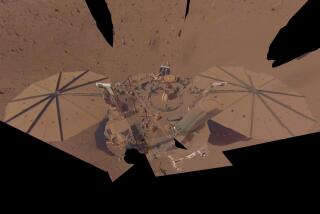Hunting for ‘marsquakes,’ NASA lander finds a surprisingly active red planet
Mars may look dry and dusty from the outside, but it has a surprisingly vibrant inner life, according to new findings from NASA’s quake-hunting InSight mission.
The lander, which touched down on the red planet 15 months ago, has detected plenty of seismic activity, an unexpectedly strong local magnetic field and around 10,000 whirlwinds passing over the Martian surface.
The findings, published Monday in a suite of six papers in the journals Nature Geoscience and Nature Communications, will help scientists unlock the secrets of Mars’ interior and understand why it looks so different from Earth.
“What these results really are showing us is that Mars is an active planet today,” said Bruce Banerdt, the mission’s principal investigator, based at NASA’s Jet Propulsion Laboratory in La Cañada-Flintridge, and a co-author of the new studies.
InSight is situated in a roughly 27-yard-wide impact crater in western Elysium Planitia, a volcanic plain whose surface material ranges in age from 3.7 billion to just 2.5 million years old. About 1,000 miles away lies Cerberus Fossae, a volcanic region full of faults, evidence of old lava flows and signs that liquid water once ran on the surface.
“Anything that’s been active in the last couple million years could be active today, especially at depth,” Banerdt said.
The lander is equipped with a dome-covered seismometer to measure quakes in Mars’ upper layers. The quake-sensing instrument also comes with a small entourage of magnetic pressure, wind and temperature sensors to filter out the “noise” generated by storms and other phenomena.
The seismometer picked up 174 marsquakes through Sept. 30, including more than 20 measuring magnitude 3 to magnitude 4. These shakers wouldn’t necessarily have felt like magnitude 3 or 4 temblors on Earth because they originated far deeper than such quakes typically do on this planet. Still, if you were standing in the right spot, you might pick it up, said Suzanne Smrekar, the mission’s deputy principal investigator.
“You’d have to be very close to feel a quake like that in California,” said Smrekar, who is based at JPL.
Suzanne Smrekar has been trying to take the temperature of Mars for nearly 25 years.
In general, tectonic activity on Mars is caused by the upper layers of the planet deforming and cracking as its interior cools and shrinks. But there are many different potential causes of individual marsquakes, and scientists said they’d need to catch more of them — particularly the larger-magnitude ones — to figure out the cause of any single event. So far, the larger quakes seem to be less frequent than scientists expected, and no “big ones” over magnitude 4 have appeared.
“Right now, we’ve got a lot more data than we have conclusions, and we’re still trying to get our arms around what Mars is telling us,” Banerdt said. “This is an entire new world of processes for us.”
On Mars, he added, “we really are in the same situation that geophysicists were [in] for the Earth back in the early 1900s. ... We’re seeing these wiggles, we’re using the best analysis tools we have, but it’s still a very mysterious situation.”
Still, two of the marsquakes were big enough to be traced to Cerberus Fossae, and it’s possible that a pocket of magma deep beneath the surface might have had something to do with them.
“We certainly don’t have direct evidence of there being magma at depth, but we do know that a couple of our quakes are occurring in an area where there has been recent geologic activity, vulcanism and faulting,” Smrekar said.
In addition, the seismometer’s magnetic pressure instrument registered a magnetic field at InSight’s landing site that was roughly 10 times stronger than expected based on satellite readings of the surrounding area’s magnetic field. That signal is likely emanating from once-molten volcanic rock deep beneath the Martian surface that bears the imprint of a far more powerful magnetic field from the planet’s long-ago past.
Scientists think ancient Mars once had a thicker atmosphere that could have encapsulated clouds in the sky and liquid water on the surface — an almost Earth-like environment with the potential to support life. But that atmosphere would only have been possible as long as a magnetic field was in place to shield it from the damaging effects of solar wind and radiation.
“That’s one of the reasons why we’re really pursuing these questions of a magnetic field on Mars, especially in its early history,” Banerdt said.
Even with the relatively paltry atmosphere that remains, the Martian surface has proved surprisingly dynamic, scientists said. InSight’s instruments have picked up evidence of around 10,000 whirlwinds that might be termed dust devils — if they had whipped up enough dust to be seen as well as felt.
Figuring out why these wind devils were so frequent, and why they didn’t seem to pick up much dust despite being strong enough to leave their mark on the surface, could help researchers understand the planet’s weather.
It will take another Earth year or so of readings for InSight to gather more clues about the planet’s inner and outer dynamics, NASA scientists said.







